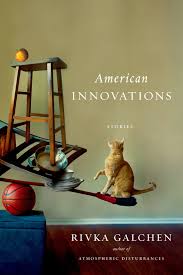American Innovations
The ten stories that make up Rivka Galchen’s American Innovations are compelling and unsettling, and feature female protagonists who are themselves unsettled. Some are predictably unsettled by men, husbands and love interests while others are entirely misfit within their lives, within their worlds. Many of the characters are reeling from a recent loss—of a job, or a relationship, or of innocence itself.
Take, for example, the protagonist of “The Lost Order”, a young woman who is recently unemployed, and has just taken a phone call from someone who thinks he’s ordering takeout from a restaurant. Rather than correct his mistake, she hangs up, and then frets:
I pour myself a glass of water, but first I spill it and then I altogether drop it, and then I clean that up poorly. I don’t even own a silver leotard. Yet I had been called out by a small and omniscient God.
She swerves from one upset to the next, giving each the same weight.
“The Lost Order” comes to an uneasy conclusion, but overall, the stories don’t resolve so much as they simply drop off. “Wild Berry Blue,” “The Entire Northern Side Was Covered With Fire,” and “Real Estate” in particular all seem to end a half-beat before readers might reasonably expect them to, a move that adds to the sensation of uneasiness. A few stories stray into the territory of the supernatural—a woman develops a breast-sized lump on her side overnight in “American Innovations” and a woman’s furniture and personal effects abandon her as she watches from the sidewalk outside her apartment in “Once An Empire” . But even in the outwardly realistic stories, the space between Galchen’s narrative world and our own is certain. These characters don’t act in ways readers will expect, and yet, their actions never completely defy the bounds of expectation, either.
I did find myself wondering about the reliability of the narrators more than once, as when the young woman in “The Region of Unlikeliness” receives a phone call from a man she has earlier been told is deceased—whether she believes that she’s being duped or that the supernatural is at work is never made clear. Are the characters deceiving themselves? Are they deceiving readers? Or are they being deceived by their worlds? Rather, it seems that the narrative space Galchen creates is an unstable one, where furniture can evacuate an apartment in the middle of the night, and the rest of the world will simply go on as it did before.
Stylistically, the prose is both elegant and sparse, and the imagery is consistently memorable. “I feel a whole birch tree pressing against my inner walls, its leaves reaching to the top of my throat—the awful sense of wanting some other life,” the pre-teen protagonist of “Wild Berry Blue” says, deep in the throes of a crush on a much older man named Roy. Galchen’s control of the narrative begins at the sentence level: the details often have a tangential quality initially, but by the end of each story, very little is wasted. And she is deft at delivering emotional vulnerability and deadpan humor in the same sentence.
“The tales in this groundbreaking collection are secretly in conversation with canonical stories, reimagined from the perspective of female characters,” the book’s jacket copy says, which is sort of an odd assertion, since it’s generally safe to assume most creative work is in dialogue with existing work of its type. In any case, readers will find echoes of the greats here—Thurber and Borges as well as Carver and Munro—but it’s also a lovely book all on its own. One need not have read any other canonical American short stories to enjoy American Innovations and the cracked-mirror version of reality it delivers.





